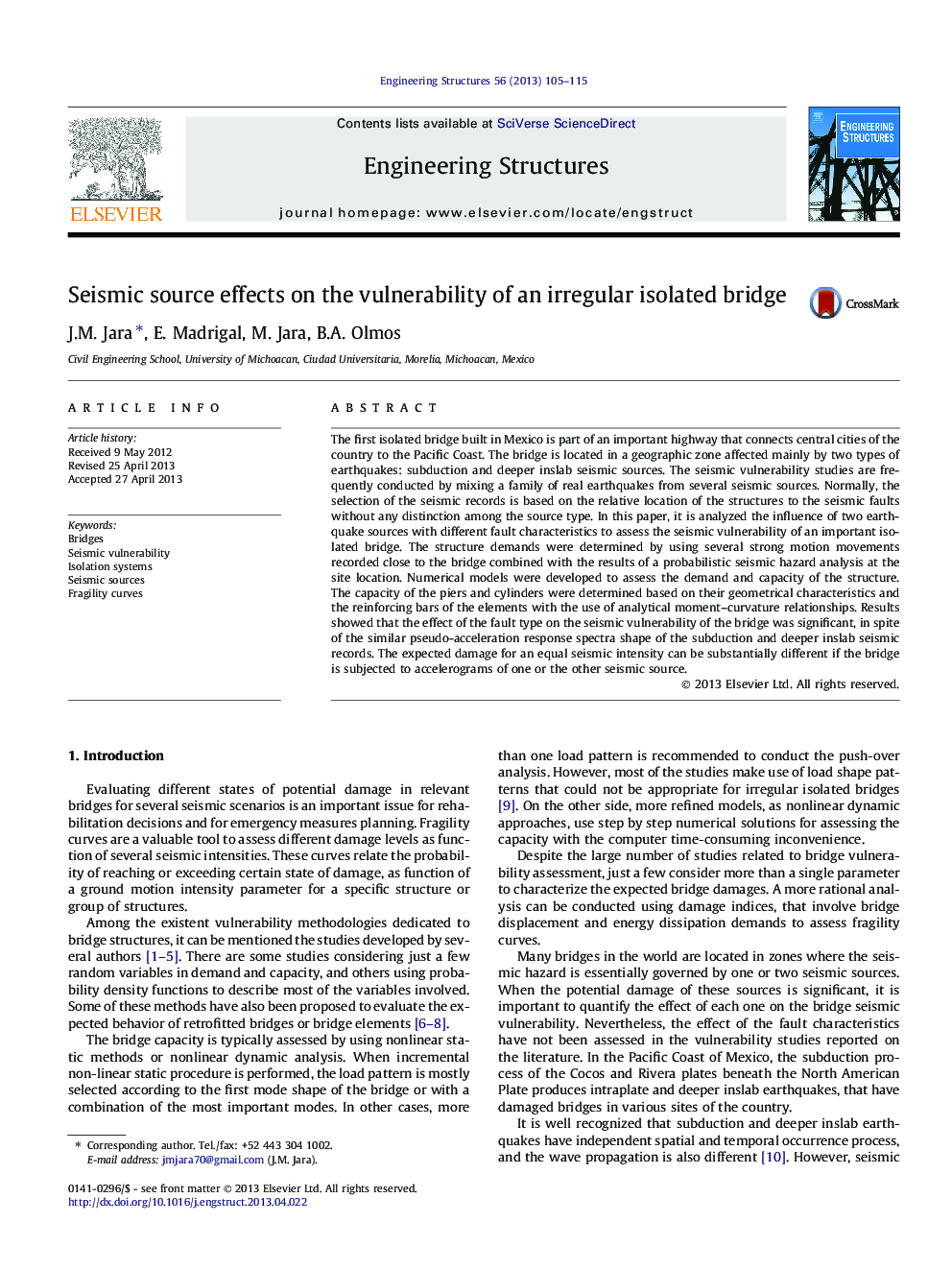| کد مقاله | کد نشریه | سال انتشار | مقاله انگلیسی | نسخه تمام متن |
|---|---|---|---|---|
| 6741251 | 504386 | 2013 | 11 صفحه PDF | دانلود رایگان |
عنوان انگلیسی مقاله ISI
Seismic source effects on the vulnerability of an irregular isolated bridge
ترجمه فارسی عنوان
اثرات منبع لرزه ای بر آسیب پذیری پل های جدا شده نامنظم
دانلود مقاله + سفارش ترجمه
دانلود مقاله ISI انگلیسی
رایگان برای ایرانیان
کلمات کلیدی
پل ها، آسیب پذیری لرزه ای، سیستم های جداسازی، منابع لرزه نگاری، منحنی های شکستگی،
ترجمه چکیده
اولین پل جدا شده ساخته شده در مکزیک بخشی از بزرگراه مهم است که شهرهای مرکزی این کشور را به ساحل اقیانوس آرام متصل می کند. این پل در یک منطقه جغرافیایی واقع شده است که به طور عمده توسط دو نوع زمین لرزه تحت تاثیر قرار می گیرد: فرورانش و منابع لرزه نگاری عمیق تر. مطالعات آسیب پذیری لرزه ای اغلب با مخلوط کردن یک خانواده از زمین لرزه های واقعی از منابع مختلف لرزه ای انجام می شود. به طور معمول، انتخاب سوابق لرزه ای بر اساس موقعیت نسبی سازه ها به گسل های لرزه ای بدون هیچ گونه تمایزی میان نوع منبع می باشد. در این مقاله، تأثیر دو منبع زمین لرزه با ویژگی های مختلف گسل برای ارزیابی آسیب پذیری لرزه ای یک پل برجسته جدا شده مورد بررسی قرار گرفته است. تقاضای ساختار با استفاده از چندین حرکات قوی حرکتی که در نزدیکی پل ثبت شده و نتایج حاصل از تحلیل احتمال خطر لرزه ای احتمالی در محل سایت مشخص شده است، تعیین شد. مدل های عددی برای ارزیابی تقاضا و ظرفیت ساختار طراحی شده اند. ظرفیت پیست و سیلندر بر اساس ویژگی های هندسی و میله های تقویت کننده عناصر با استفاده از روابط تحلیلی منحنی لحظه ای تعیین شد. نتایج نشان داد که اثر نوع گسل بر آسیبپذیری لرزه ای پل، به رغم شبیه سازی شبه شتاب مشابه شبیه سازی سوپرایزی و لرزه نگاری عمیق، قابل توجه است. آسیب مورد انتظار برای یک شدت لرزه ای برابر می تواند بطور قابل ملاحظه ای متفاوت باشد، اگر پل به شتاب دهنده های یک یا چند منبع لرزه ای دیگر اعمال شود.
موضوعات مرتبط
مهندسی و علوم پایه
علوم زمین و سیارات
مهندسی ژئوتکنیک و زمین شناسی مهندسی
چکیده انگلیسی
The first isolated bridge built in Mexico is part of an important highway that connects central cities of the country to the Pacific Coast. The bridge is located in a geographic zone affected mainly by two types of earthquakes: subduction and deeper inslab seismic sources. The seismic vulnerability studies are frequently conducted by mixing a family of real earthquakes from several seismic sources. Normally, the selection of the seismic records is based on the relative location of the structures to the seismic faults without any distinction among the source type. In this paper, it is analyzed the influence of two earthquake sources with different fault characteristics to assess the seismic vulnerability of an important isolated bridge. The structure demands were determined by using several strong motion movements recorded close to the bridge combined with the results of a probabilistic seismic hazard analysis at the site location. Numerical models were developed to assess the demand and capacity of the structure. The capacity of the piers and cylinders were determined based on their geometrical characteristics and the reinforcing bars of the elements with the use of analytical moment-curvature relationships. Results showed that the effect of the fault type on the seismic vulnerability of the bridge was significant, in spite of the similar pseudo-acceleration response spectra shape of the subduction and deeper inslab seismic records. The expected damage for an equal seismic intensity can be substantially different if the bridge is subjected to accelerograms of one or the other seismic source.
ناشر
Database: Elsevier - ScienceDirect (ساینس دایرکت)
Journal: Engineering Structures - Volume 56, November 2013, Pages 105-115
Journal: Engineering Structures - Volume 56, November 2013, Pages 105-115
نویسندگان
J.M. Jara, E. Madrigal, M. Jara, B.A. Olmos,
